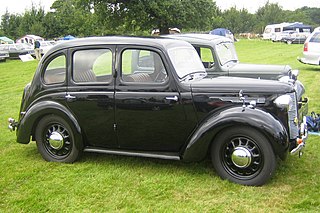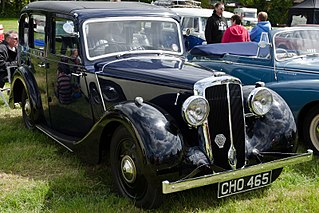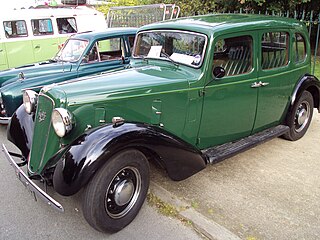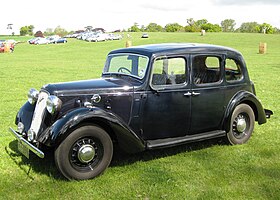
The Austin Sixteen Light Six is a British car that was made by Austin from 1927. Announced in October 1927, the first deliveries were planned for March 1928.

The Austin Cambridge is a medium-sized motor car range produced by the Austin Motor Company, in several generations, from September 1954 through to 1971 as cars and to 1973 as light commercials. It replaced the A40 Somerset and was entirely new, with modern unibody construction. The range had two basic body styles with the A40, A50, and early A55 using a traditional rounded shape and later A55 Mark IIs and A60s using Pininfarina styling.

Morris Oxford is a series of motor car models produced by Morris of the United Kingdom, from the 1913 'bullnose' Oxford to the Farina Oxfords V and VI.
Morris Cowley was a name given to various cars produced by Morris from 1915 to 1958.

The Austin Ten is a small car that was produced by Austin. It was launched on 19 April 1932 and was Austin's best-selling car in the 1930s and continued in production, with upgrades, until 1947. It fitted in between their "baby" Austin Seven which had been introduced in 1922 and their various Austin Twelves which had been updated in January 1931.

The Austin Twelve is a motor car introduced by Austin in 1921. It was the second of Herbert Austin's post World War I models and was in many ways a scaled-down version of his Austin Twenty, introduced in 1919. The slower-than-expected sales of the Twenty brought about this divergence from his intended one-model policy. The Twelve was announced at the beginning of November 1921 after Austin's company had been in receivership for six months. The number twelve refers to its fiscal horse power (12.8) rather than its brake horsepower (bhp) which was 20 and later 27. The long-stroke engines encouraged by the tax regime, 72 × 102 mm later 72 × 114.5 mm, had much greater low-speed torque than the bhp rating suggests.

The Riley Nine was one of the most successful light sporting cars produced by the British motor industry in the inter war period. It was made by the Riley company of Coventry, England with a wide range of body styles between 1926 and 1938.

The Austin 8 is a small car which was produced by Austin between 1939 and 1948.

The Rover 10 was a small family car from the British Rover car company produced between 1927 and 1947.

The Morris Ten is a medium-sized car introduced for 1933 as the company's offering in the important 10 hp sector of the British market. It continued through a series of variants until October 1948 when along with Morris's Twelve and Fourteen it was replaced by the 13.5 hp Morris Oxford MO.

The Austin Light Twelve-Six is a 14 tax horsepower car with a 1496 cc engine that was introduced by Austin in January 1931. It was named by Austin Light Twelve to separate it from the well-established Austin Twelve. The general public then dubbed the original Twelve Heavy Twelve but Austin never used that name. The Light Twelve-Six remained in production until 1936.

The Hillman Fourteen is a medium-sized 4-cylinder car announced by Hillman's managing director Spencer Wilks, a son-in-law of William Hillman, at the end of September 1925. This new Fourteen substantially increased Hillman's market share and remained on sale into 1931. During this time it was the main product of the company.

The Sunbeam-Talbot Ten is a compact executive car or small sports saloon manufactured by Rootes Group in their Clément-Talbot factory in North Kensington between 1938 and 1939, and then reintroduced after the Second World War and sold between 1945 and 1948. It was at first a two-door then a four-door sports saloon. A drophead coupé version and a sports tourer version were also available.

The Lanchester Fourteen Roadrider is a six-cylinder automobile introduced by the Lanchester Motor Company in the beginning of September 1936. It was named "Roadrider" for its special suspension features, and billed as the lowest-priced six-cylinder Lanchester ever offered. This car replaced the previous 12 hp Light Six model with a larger six-cylinder engine again in the Lanchester Eleven chassis and body.

The Austin Fourteen is a 1.7-litre saloon that was introduced by Austin in August 1936 and available as a Goodwood saloon—with a fixed or sliding head—or as a Goodwood cabriolet. The body was of steel throughout. Nominally classed by Austin as a Fourteen the actual engine size attracted tax for a 16 horsepower car. The performance of the engine carried over from the Light Twelve-Six proved disappointing and a much smoother revised version with a near 20% improvement in power output was introduced the next year.

The Austin Eighteen is a large saloon car, supplied in two different wheelbases to carry five or seven passengers, that was introduced by Austin on 14 July 1937. Its engine and front seat were mounted nine inches further forward than on the old York Sixteen it replaced. The chassis was also extended three inches to provide a total of twelve inches more passenger space. One result was a relatively short bonnet and a good driving position. Its new shape followed the lines of the other Austin cars introduced the previous autumn and it was remarkable for having a completely flat floor in both front and rear passenger compartments with exceptionally wide doors and draught-free ventilation.

The Talbot Baby is a six-cylinder executive sporting car launched by the French Talbot company in 1936. The three standard body types offered were a "coach", a two-door four-seater "cabriolet" and a two-door two-seater "cabriolet". The Baby was one of the first new models to appear after the French part of the Anglo-French Sunbeam-Talbot-Darracq combine was purchased, in 1935, by auto-entrepreneur Tony Lago. Production slowed with the onset of war and had ended completely by mid-1942 when the manufacturer's Suresnes plant was converted for war production.

Morris Twelve is a model of Morris car introduced without fanfare in the autumn of 1934 as little more than a larger engined Morris Ten Four for which just another £5 was asked. The chassis and body were of the slow-selling longer wheelbase Ten Six. The engine though awarded a tax rating of 11.98 hp had a cubic capacity of 1548cc compared with Morris's 1292cc (10 hp) Ten Four and 1378cc (12.09 hp) Ten Six.
The Singer Twelve name was used for several automobiles produced by Singer Motors. The "Twelve" in the name referred to the taxation horsepower rating in the United Kingdom.

The Vauxhall Light 6 is an automobile which was produced by Vauxhall in the United Kingdom from 1933 to 1938.


























